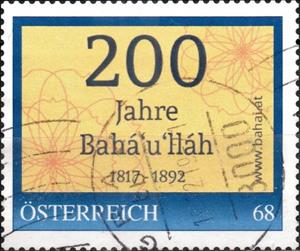Stamp: 200 years Bahá'u'lláh 1817-1892 (Austria 2017)
200 years Bahá'u'lláh 1817-1892 (Austria 2017)
01 January (Austria ) within release Meine Marke goes into circulation Stamp 200 years Bahá'u'lláh 1817-1892 face value 68 Euro cent
| Stamp 200 years Bahá'u'lláh 1817-1892 in catalogues | |
|---|---|
| Colnect codes: | Col: AT 2017-04 |
Stamp is square format.
Also in the issue Meine Marke:
- Stamp - Madonna of the Pear by Albrecht Dürer face value 68;
- Stamp - 200 years Bahá'u'lláh 1817-1892 face value 68;
- Stamp - Smile face value 68;
|
Data entry completed
46%
|
|
|---|---|
| Stamp 200 years Bahá'u'lláh 1817-1892 in digits | |
| Country: | Austria |
| Date: | 2017-01-01 |
| Emission: | Personalized - Private |
| Format: | Stamp |
| Face Value: | 68 Euro cent |
Stamp 200 years Bahá'u'lláh 1817-1892 it reflects the thematic directions:
An anniversary is the date on which an event took place or an institution was founded in a previous year, and may also refer to the commemoration or celebration of that event. For example, the first event is the initial occurrence or, if planned, the inaugural of the event. One year later would be the first anniversary of that event. The word was first used for Catholic feasts to commemorate saints. Most countries celebrate national anniversaries, typically called national days. These could be the date of independence of the nation or the adoption of a new constitution or form of government. The important dates in a sitting monarch's reign may also be commemorated, an event often referred to as a "Jubilee".
A number is a mathematical object used to count, measure, and label. The most basic examples are the natural numbers 1, 2, 3, 4, and so forth. Numbers can be represented in language with number words. More universally, individual numbers can be represented by symbols, called numerals; for example, "5" is a numeral that represents the number five. As only a relatively small number of symbols can be memorized, basic numerals are commonly organized in a numeral system, which is an organized way to represent any number. The most common numeral system is the Hindu–Arabic numeral system, which allows for the representation of any non-negative integer using a combination of ten fundamental numeric symbols, called digits. In addition to their use in counting and measuring, numerals are often used for labels (as with telephone numbers), for ordering (as with serial numbers), and for codes (as with ISBNs). In common usage, a numeral is not clearly distinguished from the number that it represents.


